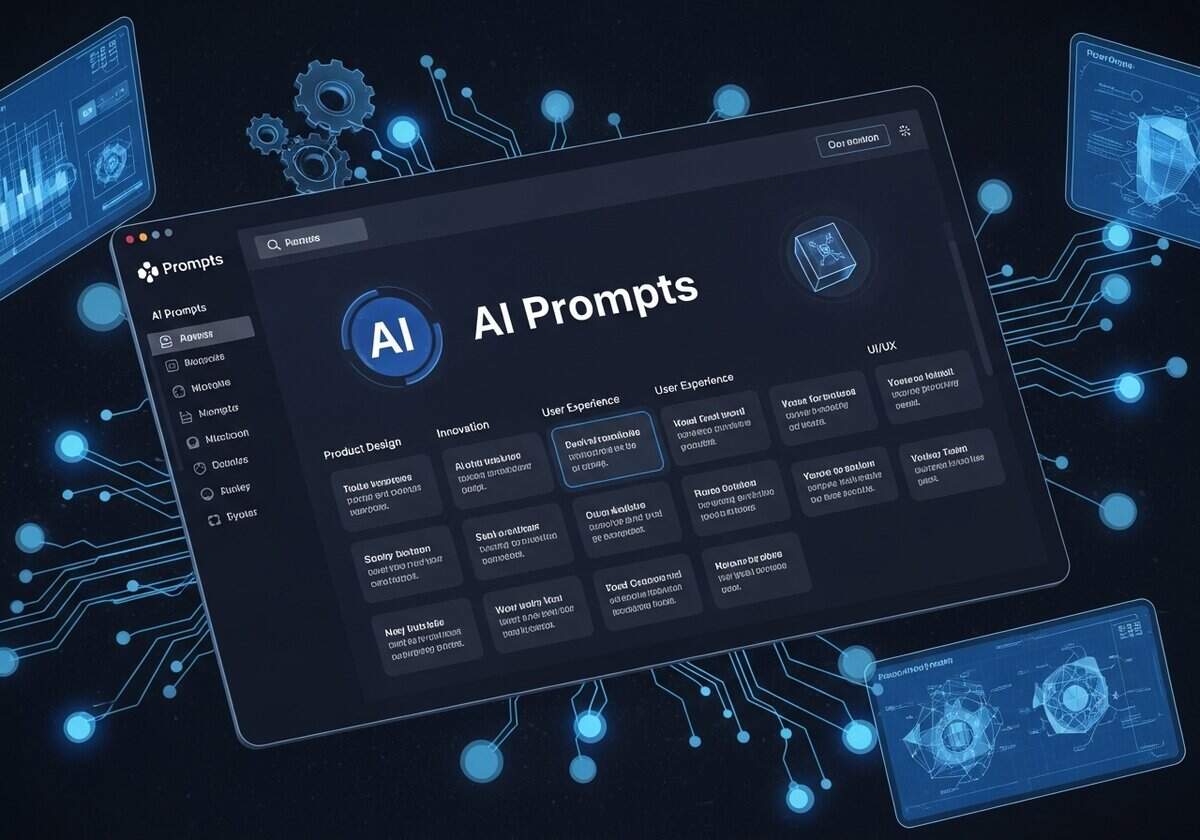Semplicemente la più grande directory di suggerimenti AI specializzata nella progettazione e nell'innovazione dei prodotti

Benvenuti nella più grande directory di istruzioni AI del mondo dedicata alla progettazione avanzata di prodotti, all'ingegneria, alla scienza, all'innovazione, alla qualità e alla produzione. Sebbene gli strumenti di intelligenza artificiale online stiano rapidamente trasformando il panorama ingegneristico aumentando le capacità umane, il loro vero potere è sbloccato attraverso istruzioni precise e sapientemente realizzate. Questo elenco completo offre una raccolta di istruzioni di questo tipo, che consentono di comandare sistemi di intelligenza artificiale in grado di elaborare grandi quantità di dati, identificare modelli complessi e generare soluzioni innovative in modo molto più efficiente rispetto ai metodi tradizionali.
Scoprite e mettete a punto i suggerimenti esatti necessari per sfruttare gli agenti AI online per ottimizzare i vostri progetti per ottenere prestazioni e producibilità massime, accelerare simulazioni complesse, prevedere con precisione le proprietà dei materiali e automatizzare una vasta gamma di attività analitiche critiche.
I filtri di ricerca avanzati consentono un accesso rapido a questa vasta directory e coprono l'intero spettro dell'ingegneria moderna.
Per motivi di tempo e di risorse del server, le richieste sono riservate ai soli membri registrati e non sono visibili in basso se non si è registrati. È possibile registrarsi, 100% gratuitamente:
È necessaria l'iscrizione
Per accedere a questo contenuto è necessario essere membri.
- Generazione di codice e debug
Prompt AI per MATLAB Script for 2D Truss FEA
- Analisi della varianza (ANOVA), Progettazione per la produzione (DfM), Ottimizzazione del design, Ingegneria, Metodo degli elementi finiti (FEM), Scienza dei materiali, Industria meccanica, Simulazione, Ingegneria strutturale
Generates a basic MATLAB script to perform a Finite Element Analysis (FEA) on a 2D truss structure. The script will take nodal coordinates, element connectivity, material properties, loads, and boundary conditions as input.
Uscita:
- MATLAB
- non richiede Internet in diretta
- Fields: {truss_geometry_and_properties_json} {load_and_boundary_conditions_json}
- Best for: Generating a foundational MATLAB script for 2D truss analysis, useful for educational purposes or as a starting point for custom FEA tools.
- Generazione o aumento dei dati
Prompt AI per Create Construction Schedule Variations
- Metodologia agile, Modellazione delle informazioni sugli edifici (BIM), Ingegneria edile, Produzione snella, Gestione del progetto, Analisi del rischio, Gestione del rischio
Generates multiple plausible variations of a construction schedule by introducing delays or accelerations to activities based on specified risk factors and their potential impacts. Helps in Monte Carlo simulations or risk analysis.
Uscita:
- CSV
- non richiede Internet in diretta
- Fields: {baseline_schedule_csv_activities_durations_dependencies} {risk_event_descriptions_and_potential_impacts_on_duration} {number_of_scenario_variations}
- Best for: Generating data for schedule risk analysis, Monte Carlo simulations, and contingency planning.
- Estrazione delle informazioni
Prompt AI per Extract Material Properties from Text
- Fabbricazione additiva, Materiali compositi, Compositi, Progettazione per la produzione additiva (DfAM), Materiali, Proprietà meccaniche, Progettazione del prodotto, Sviluppo del prodotto, Pratiche di sostenibilità
Extracts specified material properties for given materials from a block of unstructured text like a report or specification. This helps in quickly populating material databases or creating comparison sheets without manual searching.
Uscita:
- JSON
- non richiede Internet in diretta
- Fields: {document_text} {list_of_materials_and_their_properties_to_find}
- Best for: Populating material databases or comparison sheets from unstructured text, saving manual effort.
- Generazione o aumento dei dati
Prompt AI per Create Synthetic Soil Bearing Capacity Data
- Ingegneria Civile, Ingegneria edile, Progettazione per la sostenibilità, Ottimizzazione del design, Valutazione di impatto ambientale, Geotecnica, Scienza dei materiali, Controllo di qualità, Ingegneria strutturale
This prompt generates synthetic soil bearing capacity data based on input soil parameters {soil_properties_json}. The AI should produce a JSON array with multiple data points showing allowable bearing capacity values under varied depths and footing sizes for civil engineering foundation design.
Uscita:
- JSON
- non richiede Internet in diretta
- Fields: {soil_properties_json}
- Best for: Best for creating varied soil bearing capacity datasets for foundation design.
- Estrazione delle informazioni
Prompt AI per Identify Key Structural Design Codes Cited
- Ingegneria Civile, Ingegneria edile, Analisi del design, Documentazione di progettazione, Progettazione per la produzione (DfM), Progettazione per la sostenibilità, Garanzia di qualità, Gestione della qualità, Ingegneria strutturale
This prompt scans through the provided civil engineering document text {document_text} to identify and list all references to structural design codes (e.g., ACI, Eurocode, IS codes), including version/year if available. The AI must list codes uniquely and give a brief description of their scope if known.
Uscita:
- Markdown
- non richiede Internet in diretta
- Fields: {document_text}
- Best for: Best for extracting references to design standards from technical documents.
- Risoluzione dei problemi e diagnostica
Prompt AI per Troubleshoot Heat Exchanger Efficiency Loss
- Corrosione, Efficienza, Trattamento termico, Rilevamento perdite, Manutenzione, Miglioramento dei processi, Ottimizzazione del processo, Controllo di qualità, Gestione della qualità
This prompt evaluates heat exchanger operational data and symptoms to diagnose causes of efficiency loss. The AI provides a markdown report outlining potential issues like fouling, leaks, or flow maldistribution with corrective recommendations.
Uscita:
- Markdown
- non richiede Internet in diretta
- Fields: {heat_exchanger_data} {symptoms_description}
- Best for: Diagnose and address heat exchanger performance problems
- Risoluzione dei problemi e diagnostica
Prompt AI per Troubleshoot Distillation Column Anomalies
- Riciclaggio chimico, Miglioramento continuo, Analisi delle modalità e degli effetti dei guasti (FMEA), Miglioramento dei processi, Ottimizzazione del processo, Gestione della qualità, Analisi della causa principale, Controllo statistico del processo (SPC)
This prompt takes detailed operational parameters and symptoms related to a distillation column and generates a structured diagnostic report identifying likely malfunctions, their causes, and recommended fixes.
Uscita:
- Markdown
- richiede una connessione Internet in tempo reale
- Fields: {operational_parameters} {symptoms}
- Best for: Identify and fix distillation column issues efficiently
- Risoluzione dei problemi e diagnostica
Prompt AI per Diagnose Reactor Performance Issues
- Miglioramento continuo, Azione correttiva, Analisi delle modalità e degli effetti dei guasti (FMEA), Miglioramento dei processi, Ottimizzazione del processo, Controllo di qualità, Gestione della qualità, Analisi della causa principale, Controllo statistico del processo (SPC)
This prompt helps diagnose common reactor performance problems by analyzing user-provided operational data and observed symptoms. The AI outputs a prioritized list of probable root causes along with suggested diagnostic tests or corrective actions.
Uscita:
- Markdown
- richiede una connessione Internet in tempo reale
- Fields: {operational_data} {symptoms_list}
- Best for: Systematic diagnosis of reactor malfunctions
- Generazione di ipotesi
Prompt AI per Generate Hypotheses from Literature Summary
- Fabbricazione additiva, Riciclaggio chimico, Miglioramento continuo, Valutazione di impatto ambientale, Innovazione, Ottimizzazione del processo, Ricerca e sviluppo, Pratiche di sostenibilità, Sviluppo sostenibile
This prompt ingests a user-provided summary of recent literature on a chemical engineering topic and generates a list of potential hypotheses for further research, highlighting gaps or inconsistencies discovered. The output is a JSON array with hypothesis statements and supporting notes.
Uscita:
- JSON
- non richiede Internet in diretta
- Fields: {literature_summary}
- Best for: Discover new research directions from literature analysis
- Generazione di ipotesi
Prompt AI per Suggest Novel Process Optimization Hypotheses
- Miglioramento continuo, Progettazione per la sostenibilità, Efficienza, Innovazione, Produzione snella, Miglioramento dei processi, Ottimizzazione del processo, Gestione della qualità, Pratiche di sostenibilità
This prompt takes a brief description of a chemical process and suggests innovative, testable process optimization hypotheses that could improve efficiency, yield, or sustainability. The output is a markdown report detailing each hypothesis with rationale and expected benefits.
Uscita:
- Markdown
- non richiede Internet in diretta
- Fields: {process_description}
- Best for: Generate innovative ideas for process improvement































Nessuno ha discusso i potenziali pregiudizi nella selezione dell'IA per queste directory? L'intelligenza artificiale non è immune da pregiudizi, gente.